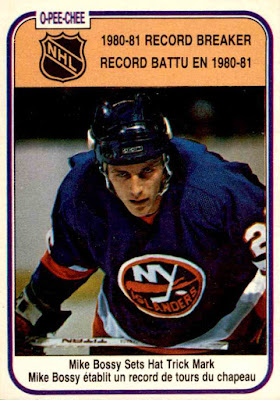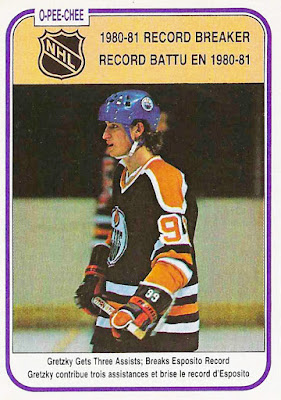That record-breaker card caught me by surprise, so much so that after writing about it I began looking deeper into the full set. Quickly I'd find the other record breaker cards. Have a look at the complete list:
 |
| #390: Hat tricks (Mike Bossy, 9) |
 |
| #391: 100+ points by each member of a forward line (Marcel Dionne, Charlie Simmer, Dave Taylor) |
 |
| #392: Points (Wayne Gretzky, 164) |
 |
| #393: Points by a rookie defenseman (Larry Murphy, 76) |
 |
| #394: Assists by a goalie (Mike Palmateer, 8) |
 |
| #395: Points by a rookie (Peter Stastny, 109) |
There was so much offense, even the goalies were putting up points! And if no player on your hometown team was setting league scoring records, you probably still watched a couple of your guys set personal scoring records. It's a trend that would continue throughout the decade. What a time to be a hockey fan.
But there's a peculiar side-note to all of this: Those record breaker cards go from #390 to #395, despite the fact that there are 396 cards in the set. So what's the final card? A checklist? A team card of the Stanley Cup champions?
No.
#396, the final card in the set, is . . .
Bob Manno.
Well that's odd. After a great run of record breaker cards, why not end the set with one more? Or push Manno back to card #390 and move all the other record breaker cards up one spot, so the set ended with the Stastny card?
I started to wonder whether O-Pee-Chee, at some point in production, thought about creating another record breaker card but then scratched it for some reason.
After some digging in the stat books, I found two possibilities:
(1) Mike Bossy put up a whopping 28 power-play goals during the 1980-81 season. Up to that point in NHL history, it was the highest total ever (he broke the former record of 27, which had been reached most recently just two seasons earlier by . . . Mike Bossy).
(2) Charlie Simmer had a record-setting shooting percentage during the 1980-81 season, and the number is so high it will knock you right out of your chair. Get ready:
32.7%
Yes. That's correct. Charlie Simmer scored on more than 3 out of every 10 shots on goal he took that season. Practically 1 out of every 3. And he scored a total of 56 goals. It was the highest NHL single-season shooting percentage ever.
But Bossy (#390, hat tricks) and Simmer (#391, Triple Crown Line) already had record breaker cards in the set. Perhaps O-Pee-Chee began working up #396 for either Bossy or Simmer, but then thought that one record breaker card for each of them was enough.
And so Bob Manno got the spot. Airbrushed into an Maple Leafs jersey. Oy.
One more theory? Another record was tied that year, and it was a big one: Mike Bossy scored 50 goals in his team's first 50 games. Maurice Richard was the first to do it, 36 years earlier, and no one had done it since.
I suppose it's possible that O-Pee-Chee had thought about reserving spot #396 for a "highlight" card of some sort to celebrate the record-tying feat, but changed their minds. Or maybe, if production schedules called for the set's design to be completed before the end of the hockey season, they were hoping Bossy would score 50 goals in fewer than 50 games, flat-out beating the record and allowing for a final record-breaker card. Or, as mentioned earlier, it could have simply been a case of too much Bossy. He already had seven cards in the set:
#198 (Base Card)
#208 (Super Action)
#219 (Team Leader)
#382 (League Leader, Goals)
#386 (League Leader, Power-Play Goals)
#388 (League Leader, Game-Winning Goals)
#390 (Record Breaker, Hat Tricks)
Regardless, think about the onslaught of goals and assists and points and rookies . . . and goalies with eight assists of their own. What an exciting season 1980-81 must have been. And we can thank O-Pee-Chee for documenting much of that excitement on cardboard.
Stay tuned for part II, coming next week.


Whoa. That's a lot of records. I wonder if there were any major rule changes prior to that season that opened up scoring so much.
ReplyDeleteGood question, Fuji. I just did some quick research on the NHL site, and didn't find any rule changes over the preceding few years that would have affected scoring in 1980-81. I suppose the game was simply changing a little bit, as Night Owl mentions below.
DeleteI'll bet card #396 was supposed to be another highlight card as you said. I don't think OPC was reluctant to add another Bossy card, they hadn't held back to that point! I have no other theory though.
ReplyDeleteI remember that time. I didn't follow hockey much, but the NHL kept popping up in the mainstream news so you couldn't help but notice. I don't think there were any rule changes that aided scoring at that time. I just think it was a greater emphasis on offense, which began in the '70s (defensemen became scorers), ramped up when expansion at the turn of the decade somewhat diluted the talent pool and then the greatest team of that era, the Oilers, had Gretzky and a whole bunch of talented offensive players and barely had to care about defense.
Heh. Good point about adding another Bossy card, Night Owl!
DeleteGood points as well about how the game had started to change. Being a goalie on those Edmonton teams must have been interesting. On the one hand, you could be pretty sure your team was going to score 4 or 5 goals per game, which must have felt great. But on the other hand, you could also be pretty sure your opponent would be shooting at you quite a bit and getting a lot of scoring opportunities.
Maybe they were late getting Manno's photo. Or they were hoping to get him in his new jersey without having to airbrush it.
ReplyDeleteI wonder what it was like to be an airbrush artist at Topps/OPC in the 1980s...
DeleteI haven't seen cards from this set before - nice looking cards, including the base card. Maybe the plan all along was to put a base card at the end.
ReplyDeleteAgreed! The base card design might be my favorite of the 1980s.
Delete